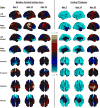Anxiety is related to indices of cortical maturation in typically developing children and adolescents
- PMID: 26183468
- PMCID: PMC5064818
- DOI: 10.1007/s00429-015-1085-9
Anxiety is related to indices of cortical maturation in typically developing children and adolescents
Abstract
Anxiety is a risk factor for many adverse neuropsychiatric and socioeconomic outcomes, and has been linked to functional and structural changes in the ventromedial prefrontal cortex (VMPFC). However, the nature of these differences, as well as how they develop in children and adolescents, remains poorly understood. More effective interventions to minimize the negative consequences of anxiety require better understanding of its neurobiology in children. Recent research suggests that structural imaging studies may benefit from clearly delineating between cortical surface area and thickness when examining these associations, as these distinct cortical phenotypes are influenced by different cellular mechanisms and genetic factors. The present study examined relationships between cortical surface area and thickness of the VMPFC and a self-report measure of anxiety (SCARED-R) in 287 youths aged 7-20 years from the Pediatric Imaging, Neurocognition, and Genetics (PING) study. Age and gender interactions were examined for significant associations in order to test for developmental differences. Cortical surface area and thickness were also examined simultaneously to determine whether they contribute independently to the prediction of anxiety. Anxiety was negatively associated with relative cortical surface area of the VMPFC as well as with global cortical thickness, but these associations diminished with age. The two cortical phenotypes contributed additively to the prediction of anxiety. These findings suggest that higher anxiety in children may be characterized by both delayed expansion of the VMPFC and an altered trajectory of global cortical thinning. Further longitudinal studies will be needed to confirm these findings.
Keywords: Anxiety; Brain development; Cortical surface area; Cortical thickness; Magnetic resonance imaging; Ventromedial prefrontal cortex.
Conflict of interest statement
Jean A. Frazier has received research support from GlaxoSmithKline, Pfizer, Inc., Neuren, Roche, and Seaside Therapeutics, NICHD, NIMH, NINDS and has served on a Data Safety Monitoring Board for Forest Pharmaceuticals. Anders M. Dale is a founder of and holds equity interest in CorTechs Labs, La Jolla, CA and serves on its scientific advisory board. The terms of this arrangement have been reviewed and approved by UC San Diego, in accordance with its conflict of interest policies. All other authors reported no biomedical financial interests or potential conflicts of interest.
Figures



References
-
- Aben I, Denollet J, Lousberg R, et al. Personality and vulnerability to depression in stroke patients: a 1-year prospective follow-up study. Stroke. 2002;33:2391–2395. - PubMed
-
- Armstrong KA, Khawaja NG. Gender differences in anxiety: an investigation of the symptoms, cognitions, and sensitivity towards anxiety in a nonclinical population. Behav Cognit Psychother. 2002;30:227–231.
-
- Biederman J, Rosenbaum JF, Bolduc-Murphy EA, et al. A 3-year follow-up of children with and without behavioral inhibition. J Am Acad Child Adolesc Psychiatry. 1993;32:814–821. - PubMed
Publication types
MeSH terms
Grants and funding
LinkOut - more resources
Full Text Sources
Other Literature Sources
Medical

